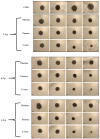Advancing Radiobiology: Investigating the Effects of Photon, Proton, and Carbon-Ion Irradiation on PANC-1 Cells in 2D and 3D Tumor Models
- PMID: 39851965
- PMCID: PMC11763791
- DOI: 10.3390/curroncol32010049
Advancing Radiobiology: Investigating the Effects of Photon, Proton, and Carbon-Ion Irradiation on PANC-1 Cells in 2D and 3D Tumor Models
Abstract
Introduction: Pancreatic cancer (PC) is one of the most aggressive and lethal malignancies, calling for enhanced research. Pancreatic ductal adenocarcinoma (PDAC) represents 70-80% of all cases and is known for its resistance to conventional therapies. Carbon-ion radiotherapy (CIRT) has emerged as a promising approach due to its ability to deliver highly localized doses and unique radiobiological properties compared to X-rays. In vitro radiobiology has relied on two-dimensional (2D) cell culture models so far; however, these are not sufficient to replicate the complexity of the in vivo tumor architecture. Three-dimensional (3D) models become a paradigm shift, surpassing the constraints of traditional models by accurately re-creating morphological, histological, and genetic characteristics as well as the interaction of tumour cells with the microenvironment. Materials and Methods: This study investigates the survival of pancreatic cancer cells in both 2D and spheroids, a 3D model, following photon, proton, and carbon-ion irradiation by means of clonogenic, MTT, spheroid growth, and vitality assays. Results: Our results demonstrate that carbon ions are more efficient in reducing cancer cell survival compared to photons and protons. In 2D cultures, carbon-ion irradiation reduced cell survival to approximately 15%, compared to 45% with photons and 30% with protons. In the 3D culture model, spheroid growth was similarly inhibited by carbon-ion irradiation; however, the overall survival rates were higher across all irradiation modalities compared to the 2D cultures. Carbon ions consistently showed the highest efficacy in reducing cell viability in both models. Conclusions: Our research highlights the pivotal role of 3D models in unraveling the complexities of pancreatic cancer radiobiology, offering new avenues for designing more effective and precise treatment protocols.
Keywords: 2D cell cultures; 3D cell culture models; conventional radiotherapy; hadrontherapy; pancreatic cancer; radiobiology; spheroids.
Conflict of interest statement
The authors declare no conflicts of interest.
Figures





References
-
- Pourshams A., Sadaf G.S., Kevin S.I., Catherine B., Saeid S., Gholamreza R., Mehdi S., Khatibian M., Fitzmaurice C., Nixon M.R., et al. The Global, Regional, and National Burden of Pancreatic Cancer and Its Attributable Risk Factors in 195 Countries and Territories, 1990–2017: A Systematic Analysis for the Global Burden of Disease Study 2017. Lancet Gastroenterol. Hepatol. 2019;4:934–947. doi: 10.1016/S2468-1253(19)30347-4. - DOI - PMC - PubMed
-
- Ren S., Qian L.C., Cao Y.Y., Daniels M.J., Song L.N., Tian Y., Wang Z.Q. Computed Tomography-Based Radiomics Diagnostic Approach for Differential Diagnosis Between Early- and Late-Stage Pancreatic Ductal Adenocarcinoma. World J. Gastrointest. Oncol. 2024;16:1256–1267. doi: 10.4251/wjgo.v16.i4.1256. - DOI - PMC - PubMed
MeSH terms
LinkOut - more resources
Full Text Sources
Medical

